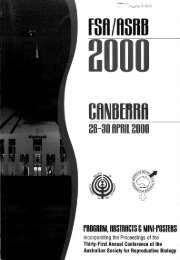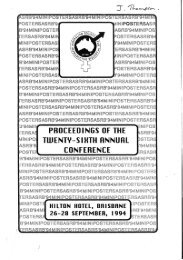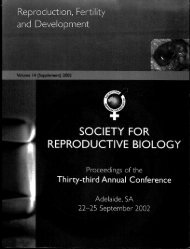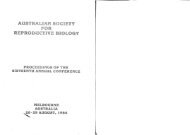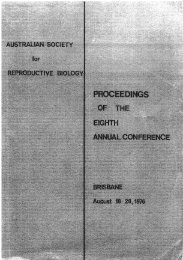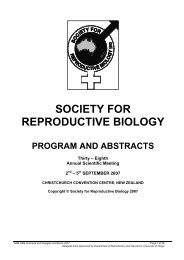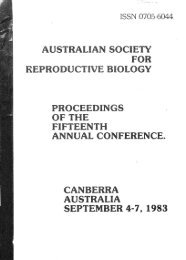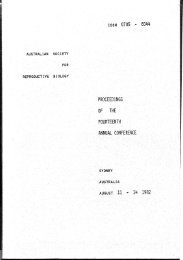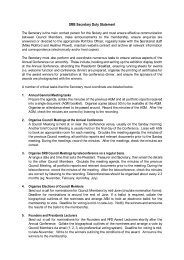N OCIETY' - the Society for Reproductive Biology
N OCIETY' - the Society for Reproductive Biology
N OCIETY' - the Society for Reproductive Biology
You also want an ePaper? Increase the reach of your titles
YUMPU automatically turns print PDFs into web optimized ePapers that Google loves.
SUCCESSFUL DEVELOPMENT OF A 6·DMAP REPLACEMENT FOR BOVINE OOCYTEACTIVATION RESEARCH.W.G. James, O.La~ham-Kaplan and A.a. TrounsonInstitute ofReproduction and Development, Monash University, Melbourne, Australia.IntroductionAn efficient method of activation following nucleartransfer and sperm injection in bovine is necessary toinduce successful preimplantation development. Theactivation treatment currently considered to be <strong>the</strong>most successful is <strong>the</strong> Ca++-ionophore A23187followed by 6-dimethylaminopurine (6-DMAP) (1).A similar success with oocyte activation has beenobserved in <strong>the</strong> sheep with ethanol exposure followedby 6-DMAP (2). However, concerns have been raisedto <strong>the</strong> effects <strong>the</strong> non-specific protein kinase inhibitor6-DMAP might have on embryo development (3,4).6-DMAP has been shown to accelerate <strong>the</strong>disappearance of phosphorylated <strong>for</strong>ms of proteins.Development of 6-DMAP treated mouse embryosresulted in severely compromised post-implantationdevelopment with no live pups born (3).The agentcycloheximide can be used to replace 6-DMAP,targetting <strong>the</strong> syn<strong>the</strong>sis of proteins ra<strong>the</strong>r than <strong>the</strong>irphosphorylation. Cycloheximide treatment is capableof activating both young and aging oocytes at highrates. The majority of o<strong>the</strong>r artificial stimuli areunable to activate young oocytes adequately (5). Thishas often limited nuclear transfer procedures to <strong>the</strong>use of aging oocytes, in which cytoskeletaldeterioration has been observed (5). The presentstudy investigated <strong>the</strong> effect of cycloheximidetreatment following ethanol exposure on IVM bovineoocytes.Materials & MethodsImmature oocytes were aspirated from abattoircollected ovaries and matured in-vitro <strong>for</strong> 24hr (6).Prior to activation, oocytes were denuded of allcumulus by vortexing <strong>for</strong> 3min in 50111 hyaluronidasesolution (lmg/ml). Mature oocytes that had extrudeda ~rst. polar body were used <strong>for</strong> <strong>the</strong> study. TheactIvatIOn treatments which were examined are: [1]A23187 (38IlM; 10min) followed by 6-DMAP (2JlM;5hr); [2] ethanol (7%;5min) followed by 6-DMAP(2IlM ; 5hr); [3] ethanol (7%;5min) followed bycycloheximide (IOllg/ml) and cytochalasin-B(5Ilg/ml) (5hr); [4] ethanol alone (7%;5min). 6DMA~ treatment results in diploid parthogenomes,so to SImulate this cytochalasin-B was combined with<strong>the</strong> cycloheximide treatment. Treated oocytes werewashed through drops of equilibratedSOF120AAIBSA medium, and cultured <strong>for</strong> 3 days inSOF120AAIBSA at 39°C at 7% O 2, 5% CO , 288% N rOn day 3 (day 0 = day of activation) par<strong>the</strong>noteswere transferred to fresh medium and cultured <strong>for</strong> afur<strong>the</strong>r 4 days, after which blastocyst <strong>for</strong>mation wasdetermined.ResultsNo significant difference in cleavage rates wasobserved between <strong>the</strong> activation treatments thatproduce diploid parthogenomes (Table 1). However,<strong>the</strong> cleavage rate of ethanol treated eggs, whichproduces haploid parthogenomes, was significantlylower than <strong>the</strong> diploid treatments. No significantdifference in blastocyst <strong>for</strong>mation rates was observedbetween <strong>the</strong> A23187/6-DMAP and Eth/6-DMAPtreatments, however, a significantly higher rate wasobserved between Eth/cyclo/cytoB and Eth/6-DMAP(P



